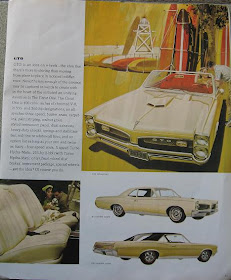


These pictures taken from old brochures have become telltale signs of Detroit’s three big automakers' ominous future, culminating in their maybe going to the bankruptcy chopping block if not rescued by a bail-out. For this non-prescient but hindsight observation, I went through my trusty time-capsule files of the 60’s.
Thus while Detroit was then devotedly churning out huge monsters like the GTO, Bonnevile, Caprice, Grand Prix, etc, upstart Japanese automakers were silently promoting to market their tiny little cars that could not even be allowed on US freeways due to miniscule engine size and other basic standards. As small as 360cc engines but able to seat 4 passengers. Mitsubishi’s Minica was an early forerunner in the Asian markets. Honda did come out just as early with its Civic but focused on the US markets with their heftier engines of at least a 1000cc.
In a real way, the 60’s also shows the world’s cluelessness, or maybe just inattention, about the need to conserve existing energy sources and/or aim for more efficient uses of energy. Because many dismissed these actions by the Japanese as simply the manufacture of oversized toys, not good enough as acceptable human transport. But Honda successfully marketed their earlier versions in the US, promoted primarily as “second” cars, not the main transport for the family or the parents.
For me, I actually purchased a Minica, but the earlier version of the one pictured here and imported completely assembled from Japan. It kept its value well, since I was able to sell mine more than 2 years later for almost the same price as the purchase price.
How the world has changed since then.
You go WAY back too far. In the 60s gas was like 30 cents a gallon. Right up until 2 or 3 years ago Detroits "Big 3" was making mad money on SUVs. Their mistake is that they put ALL their eggs in THAT one basket. The Japanese ALSO made huge profits with that product; BUT, they also continued to produce smaller cars, flex fuel autos, hybrids and straight electric. And theres another even bigger problem GM, Ford and Chrysler has to deal with--UNIONS! Take a look at what the average UAW person makes a year in pay and bennies. Now tell me how ANY company can compete with THAT level of overhead to deal with?
ReplyDeleteRight you are, Phil:
ReplyDeleteThe unions have helped make Detroit very much less competitive with the other automakers.
Per latest tally as much as $2000 is added per car representing union benefits and pension plans.
Making this a truly valid case to allow the Big 3 to go bankrupt, and thus allow them to renegotiate all these contracts with the eye toward gaining more competitiveness in the global markets.
It is good to note that the Big 3 compete well in European and other markets where the unions cannot reach them.
Only 2K? Well thats not so bad. I thought two or three times that. Anyway, the rift between blue collars and salary is as bad today as it was when my old man had to join the union to work as an electrician after his 20 in the AF. The attitudes among the rank and file was quite disconerting for him after the sense of mission and duty he tried to bring to the job from the military. His new comrades, whenever referring to the company, always spoke of it as "them" against "us." His stories made me scorn the idea of ever wanting to work in the civilian world... and I never did.
ReplyDeletePhil:
ReplyDeleteHere's an excerpt from an editorial from IBD (Investor's Business Daily) from July of this year:
These union contracts — not poor quality, inferior design, or mismanagement — cost GM an additional $2,500 for each car it builds. GM can either pass the costs on to consumers or absorb the losses. But no matter which decision GM makes, the company finds itself in a death spiral. At higher prices, GM cannot compete; if it eats the costs, it loses money.
Add another $300 to $500 per car due to productivity-stifling union-demanded work rules that foreign makers don't have deal with, and it becomes clear why the problems that have been piling up on the domestic makers have become a mountain.